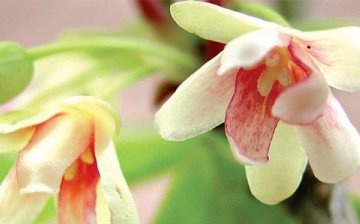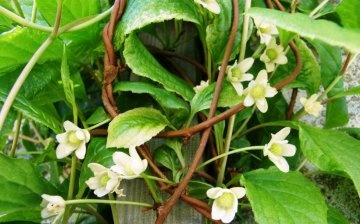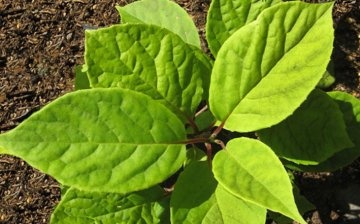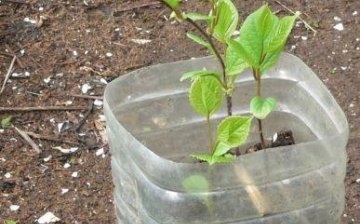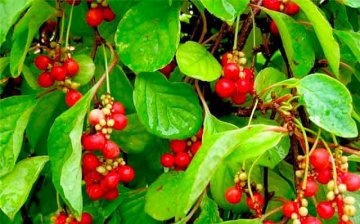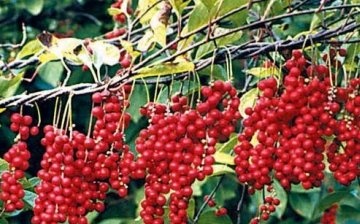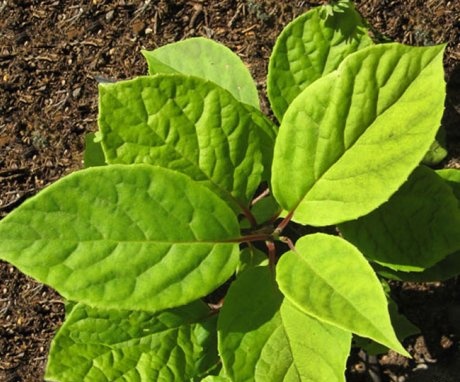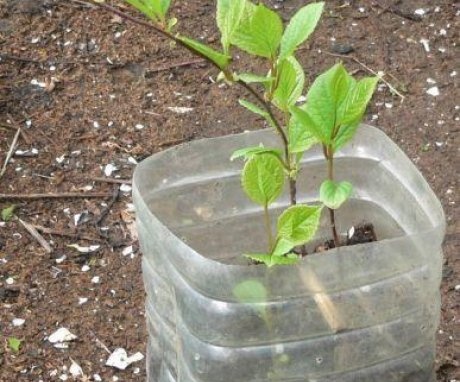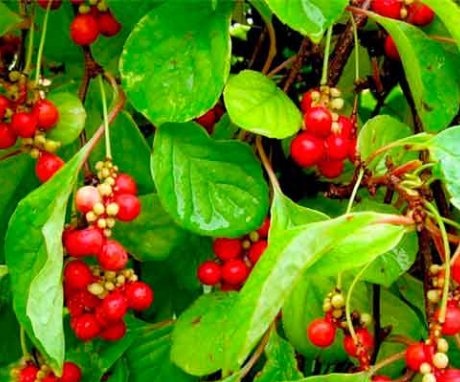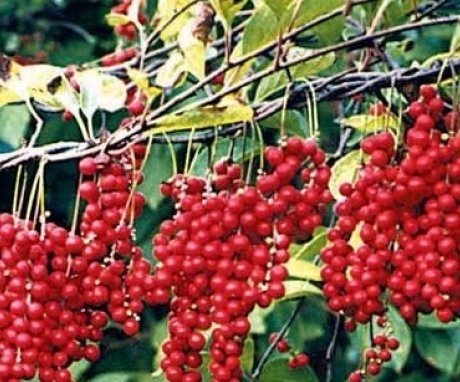Schisandra: flowers of irresistible beauty and useful fruits
Of the many climbing plants growing in the territories of Europe and Russia, one of the most useful is lemongrass. Having many species, only one has taken root in these territories - Chinese. Despite its name, only the scent of foliage unites it with lemon. If you rub them, then you can clearly hear the aroma of this citrus. Lemongrass is native to the southeastern and eastern parts of Asia.
- General information about lemongrass
- Lemongrass care
- Reproduction of lemongrass
- Useful properties of the plant
- Application in landscape design
General information about lemongrass
How lemongrass flower chinese does not stand out much, although when blooming, the plant has a very delicate appearance. It is mainly used for medicinal properties.
In appearance, lemongrass is:
- Liana with lignified climbing branches, which belongs to the Schisandra family.
- it can reach up to 5–8 meters, and in rare cases, up to 15 meters.
- The branches themselves in the section do not even reach 2 centimeters in diameter.
- When this plant is planted at the support, branching vines densely entwine all the free space.
- Leaves of lemongrass are fleshy, large in length reaching 7 cm. They are oval, oblong in shape.
- From the upper part, the leaves are glossy and have a dark green color, from the lower part they are bluish and matte.
- By autumn, the leaves turn yellow or orange-yellow and fall off by winter.
- The flowers of lemongrass are white-yellow or white-pink in color, have a small size and a pleasant aroma when blooming.
The flowering period lasts 15 days, starting in the first half of June.
On one bush, both female and male flowers can bloom in one season. In another season, only same-sex, which can lead to crop loss. Therefore it is recommended plant next to each other right away 2-3 bushes of this plant. Fruit ripening occurs at the beginning of autumn.
Schizandra berries are round, juicy, small in size, bright red in color, collected in a brush that looks like currants. This entire brush of lemongrass, the length of which can reach 10 cm, is the fruit. Each berry contains two kidney-shaped bones.
Lemongrass care
When planting lemongrass on the site, several nuances must be taken into account. It is best to choose a place that is sunny, where there will be no drafts, for example, near the house. The land must be well drained so that the water does not stagnate. The period for disembarkation is chosen in spring, late April and early May. The distance between adjacent bushes should be at least 1 meter.
The plant does not require special care for itself, and by giving the plant a minimum of time, you can get a beautiful ornamental bush and a good harvest from it.
Young lemongrass needs more careful care:
- After planting, the plant must be watered abundantly and mulch with humus or compost. This prevents moisture loss and, at the same time, is an excellent top dressing for a young bush.
- During the dry summer heat, the plant must be sprayed with clean water.
- And starting from the 3rd year of life, lemongrass can be fed with saltpeter in the spring and 1 time in 2-3 weeks in the summer with organic fertilizers.
- It is also necessary to take into account that lemongrass is a moisture-loving plant, and in the hot season it needs good regular watering, at the rate of 5-6 buckets per shrub. Do not let the ground under the bush dry out.
- Pruning is optional for this plant, but it is recommended to do it every year to strengthen the bush. To this end, in mid-March, it is necessary to prune the upper part of the vines, dried and unhealthy branches and remove some of the adventitious branches.
- In the first years after planting, it is necessary to regularly pdry up the ground around lemongrass and remove weeds, an adult plant independently clogs them with its branches and foliage.
Warming of adult lemongrass bushes for the winter is not required, this plant is quite winter-hardy. But it is worth taking care of young bushes up to 5 years old, they can be covered with dry fallen leaves or spruce branches.
Reproduction of lemongrass
Under natural conditions, lemongrass reproduces with using seedscarried by birds, and by root suckers, which creates dense growth in the places where this plant grows. At home, cultural conditions, Schisandra chinensis is cultivated in several ways: by seeds, root suckers and cuttings.
The seeds are collected from well-ripened berries and are stored for no more than 6 months, after this period they lose their germination properties. To collect the seeds, it is necessary to separate them from the pulp, for this you can put them for a while in wet sand. After that, the seeds are washed and laid back in fresh sand until sowing.
The seed container should be stored in a basement or other cool and damp place.
In the spring, seeds are sown in the beds. The sowing depth should not be deep, up to 2 cm. After that, the beds are well watered and mulched with peat. When the beds are sufficiently warmed by the sun, the crops begin to sprout. They must be shaded from direct sunlight and water regularly... Such plants are planted the next year for growing, and after another year, young lemongrass can already be planted in a permanent place of growth.
In order to propagate lemongrass using root suckers, you must:
- In the spring, sprinkle the rhizome with fertile soil, by the fall, the already developed root can be divided into bushes and planted in new places.
- You can also dig in a couple of vine branches in the spring, after a while the branches, being in the ground, take root.
- After a year, the new bush can already be separated from the mother plant.
- This method is one of the easiest and is most often used by gardeners.
A difficult breeding method is with summer cuttings:
- Important prepare cuttings from young and strong branches. The lower part of such a cutting should be slightly lignified, while the top is still green.
- Each branch cut should have at least 2 internodes and 2-3 leaves.
- Further, the cuttings must be immersed in a solution with a component that stimulates rooting to a depth of 1.5 cm.
- After that, plant on beds with prepared fertile soil for further rooting of the plant.
It is recommended to sprinkle the beds on top with river sand and cover from direct sunlight with burlap or gauze folded several times.
It is necessary to moisten the plantings several times a day with the obligatory wetting of gauze or burlap. For the winter, the cuttings are insulated, and in the spring they are planted for growing with regular watering.
Planting lemongrass:
- To plant a young bush in a permanent place, you need to dig a hole 60 cm deep and in diameter.
- If there are several bushes, then you can dig a trench with the same parameters.
- At the bottom of the recess, it is necessary to place a drainage layer of about 15 cm, a mixture of sod soil with humus or humus is poured on top.
- Further, the bushes are planted at a distance of about 1 meter, deepening them when planting to the root collar.
- After, the young bush must be well watered and mulched.
Useful properties of the plant
Schisandra is more medicinal than ornamental plant... Therefore, it is planted in dachas not only for beauty, but for collecting useful berries and leaves of this plant.
Collection and procurement:
- Lemongrass is harvested in September and October, during this period they reach full maturity.
- This can be seen in the fact that the berries become transparent, and their color is uniform.
- This process must be carried out very carefully, cutting off the brushes with berries with sharp scissors or a knife.
- If you damage a branch, then next year it will not have an ovary.
You need to choose a suitable container, it can be a basket or an enamel pan.
Galvanized dishes should be avoided, as the berries will oxidize them with their juice. The berries must be processed within 24 hours, otherwise they will lose a large percentage of their beneficial qualities after harvesting. They can also rot or mold very quickly.
The fruits can be dried using a home oven preheated to 60 degrees. This activity will take 3-4 days. Dried berries retain almost all of their beneficial properties.
Application in landscape design
Since ancient times, lemongrass used in folk medicine... And with the development of new technologies, this plant has become increasingly used in traditional medicine.
There are many useful substances in berries.
Since they have tonic properties, they are often recommended for people with hypertension.
Eating 50 grams of freshly picked berries, even a healthy person has an increase in strength and tone. Lemongrass leaves have the same properties. They can be used to make tea, which is not recommended to drink at night, because of the same tonic effect.
The berries of this plant are also used in medicine:
- From the dried fruits of schisandra chinensis, alcoholic infusions are made, which are excellent as a stimulant for mental or physical fatigue. They are also great for those who have begun to decline in visual acuity.
- It is important to note that preparations based on lemongrass are not toxic. And the oil of this plant is used in cosmetics and perfumery.
In landscape design:
- Lemongrass is used as a greenery for gazebos and fences.
- It can also be planted near dead trees.
For 2-3 years, the vines of the plant, densely wrapping around the supports, will create dense greenery. In the early summer month, lemongrass pleases with gentle flowering, and in the fall it turns into a red-yellow spectacular composition consisting of yellow foliage and bright, red fruits. Looks very impressive both in the garden and near the house or gazebo.
More information can be found in the video.



